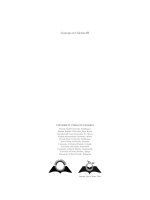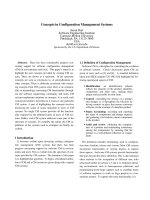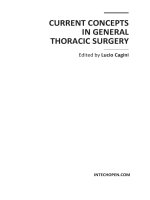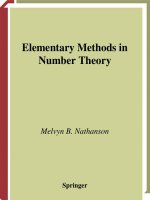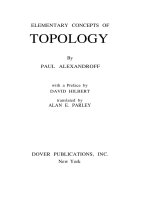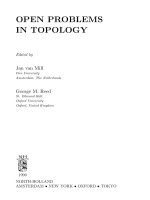elementary concepts in topology - p. alexandroff
Bạn đang xem bản rút gọn của tài liệu. Xem và tải ngay bản đầy đủ của tài liệu tại đây (2.2 MB, 62 trang )
ELEMENTARY CONCEPTS OF
TOPOLOGY
By
PAUL ALEXANDROFF
with a Preface by
DAVID HILBERT
translated by
ALAN E. PARLEY
DOVER PUBLICATIONS, INC.
New York
TRANSLATOR'S PREFACE
IN
TRANSLATING
this
work,
I
have
made
no
attempt
to
revise
it, but
have
merely tried to preserve it in its proper historical perspective, and have
made only a few minor modifications and corrections in the process. I have
inserted a footnote and several parenthetical notes in an effort to clarify
the material or to indicate the current terminology, and have actually
changed the notation in several places (notably that for the homology
groups) to avoid confusion and to bring it into consonance with modern
usage.
I wish to express my gratitude to Jon Beck, Basil Gordon and Robert
Johnstone for their invaluable aid in the preparation of this translation.
ALAN E. PARLEY
Ann Arbor, Michigan
January, 1960.
PREFACE
FEW
BRANCHES
of
geometry
have
developed
so
rapidly
and
successfully
in recent times as topology, and rarely has an initially unpromising branch
of a theory turned out to be of such fundamental importance for such a
great range of completely different fields as topology. Indeed, today in
nearly all branches of analysis and in its far-reaching applications, topo-
logical methods are used and topological questions asked.
Such a wide range of applications naturally requires that the conceptual
structure be of such precision that the common core of the superficially
different questions may be recognized. It is not surprising that such an
analysis of fundamental geometrical concepts must rob them to a large
extent of their immediate intuitiveness—so much the more, when in the
application to other fields, as in the geometry of our surrounding space,
an extension to arbitrary dimensions becomes necessary.
While I have attempted in my Anschauliche Geometric to consider spatial
perception, here it will be shown how many of these concepts may be
extended and sharpened and thus, how the foundation may be given for a
new, self-contained theory of a much extended concept of space. Never-
theless, the fact that again and again vital intuition has been the driving
force, even in the case of all of these theories, forms a glowing example of
the harmony between intuition and thought.
Thus the following book is to be greeted as a welcome complement to
my Anschauliche Geometric on the side of topological systematization;
may it win new friends for the science of geometry.
DAVID HILBERT
FOREWORD
THIS
LITTLE
book
is
intended
for
those
who
desire
to
obtain
an
exact
idea
of at least some of the most important of the fundamental concepts of
topology but who are not in a position to undertake a systematic study of
this many-sided and sometimes not easily approached science. It was
first planned as an appendix to Hilbert's lectures on intuitive geometry,
but it has subsequently been extended somewhat and has finally come
into the present form.
I have taken pains not to lose touch with elementary intuition even in
the most abstract questions, but in doing so I have never given up the
full rigor of the definitions. On the other hand, in the many examples I have
nearly always dispensed with the proofs and been content with a mere
indication of the state of affairs which the example under consideration
served to illustrate.
Mindful of this latter end, I have picked out of the extensive subject
matter of modern topology only one set of questions, namely those which
are concentrated on the concepts of complex, cycle and homology; in
doing so I have not shied away from treating these and related questions
in the full perspective appropriate to the modern state of topology.
With respect to the basis for the choice of materials appearing here, I
have included a paragraph (46) at the end of this book.
Of course, one cannot learn topology from these few pages; if however,
one gets from them some idea of the nature of topology—at least in one
of its most important and applicable parts, and also acquires the desire for
further individual study—then my goal will have been reached. From this
point of view let me direct those of you who already have the desire to
study topology to the book written by Herr Hopf and myself which will
soon be printed by the same publisher [see footnote 4—A.E.F.].
I should like to express my warmest thanks to S. Cohn-Vossen and
O. Neugebauer, who have read this book in manuscript form as well as in
proof and have given me worthwhile advice on many occasions.
My sincere thanks also to Mr. Ephrämowitsch at Moscow and Mr.
Singer at Princeton, who most kindly undertook the drawing of the figures.
P. ALEXANDROFF
Kljasma at Moscow,
May 17,
1932.
CONTENTS
Introduction
1
I. Polyhedra, Manifolds, Topological Spaces . 6
II. Algebraic Complexes . . . . . 11
III. Simplicial Mappings and Invariance Theo-
rems
30
Index
56



